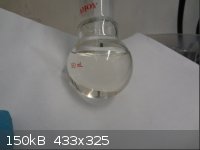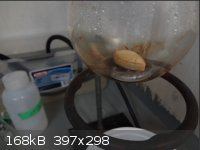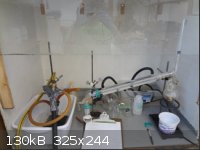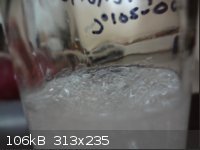Synthesis of Acetophenone
Introduction
Acetophenone is an aromatic ketone with a pleasant odor. It is a chemical that has many uses as a precursor and as a flavoring for various foods. In
this experiment Acetophenone is prepared from benzene and acetic anhydride with anhydrous aluminum chloride.
WARNING! This reaction deals with corrosive acids, toxic fumes and poisonous liquids. It is advised not to perform this unless you are a trained
chemist with proper laboratory equipment. This is to be performed in a fumehood.
This is a classic example of a Friedel Crafts acylation. A mechanism for the reaction can be found at this link:
http://www.chm.wright.edu/feld/chm216/CHM%20216%20Ex%205%20F...
Table of Reagents
120g anhydrous aluminum chloride
185mL anhydrous benzene
36mL acetic anhydride
450mL concentrated hydrochloric acid
450g crushed ice
50mL diethyl ether
50mL 10% sodium hydroxide solution
Reaction
A 1L 3-neck RBF was set up on a cold water bath that could be raised or lowered. To the top neck a mechanical stirrer was added. To another neck a
60mL addition funnel containing the acetic anhydride was added and to the third neck a reflux condenser was added with a gas trap connected to the
top. The gas trap consisted of an inverted funnel into a beaker of water with a drying tube in between in case moist air were to be sucked into the
system. Stirring was started and the ice bath was raised. The acetic anhydride was slowly dripped into the flask over the course of 30mins. There was
some sort of white solid residue that build up where the acetic anhydride was being dripped in, it eventually fell in and bubbled vigorously. Once all
the acetic anhydride had been added the mixture was refluxed for an hour. The reaction mixture turned a deep orange/brown colour part way through the
acetic anhydride addition. At the start of the reflux period the mixture fizzed smoothly. A lot of hydrogen chloride gas could be seen dissolving into
water in the gas trap. Once reflux was done the heat was removed and the reaction was allowed to cool back down to room temperature on its own. Near
the end of reflux there was no more hydrogen chloride being emitted.
Work-Up
The cooled reaction mixture was poured into a mixture of 450mL concentrated hydrochloric acid and 450g of ice. WARNING! THIS STEP IS VERY VIOLENT. The
quenching of the reaction mixture liberated enormous amounts of heat and hydrogen chloride and probably lots of benzene fumes. Once the reaction had
all been poured into the ice/HCl mixture it was stirred for 15 mins to fully quench the organic layer. The mixture was then transferred to a
separatory funnel with 25mL of ether. The funnel was well shaken and the aqueous layer and organic layer were separated into different Erlenmeyer
flasks. The aqueous layer was then extracted with another 25mL portion of ether. Remove the aqueous layer and discard it. Add the organic layer back
into the separatory funnel and wash it with two 25mL portions of a 10% sodium hydroxide solution. Drain the organic layer into a clean Erlenmeyer
flask and dry it with anhydrous magnesium sulfate.
Purification
Take the organic layer and remove the ether/benzene mixture by distilling off on a water bath, or use a rotovap if available. Once all of the solvent
has been removed, transfer the crude Acetophenone to a clean distillation apparatus and distill using an air condenser. Collect the fraction boiling
between 195-202 C. Pure Acetophenone should be clear and I obtained a product that was slightly tan in colour. The Acetophenone was then redistilled
to collect a perfectly clear sweet cherry scented liquid. The total weight of Acetophenone obtained was 32.94g which was a 71.8% yield based off
acetic anhydride. The melting point of the obtained Acetophenone was 17.2-19.5 C. The Acetophenone was collected boiling between 200-201C in the
second distillation. The lit. value for the boiling point of acetophenone is 202C. The lit. value for the melting point of acetophenone is 19-20C.
Important Notes about the reaction:
-The glassware must be absolutely anhydrous as water decreases the yield. For this procedure all of the glassware was flame dried
-The benzene must be dried and it is advantageous to remove any sulfur impurities as it may interfere with the reaction, the benzene used in this
procedure was purified as per Vogel 3rd Ed to remove thiophene. The benzene was then dried using anhydrous magnesium sulfate and 3A molecular sieves,
filtered then distilled
-The chemicals used in this experiment are TOXIC!, especially the benzene and anhydrous aluminum chloride. This procedure is to be preformed in an
efficient fumehood, especially during the quenching stage.
-The Acetophenone can be distilled under a vacuum but it works just as well to distill it under atmospheric pressure. The distillation may only need
to be performed once if one is very careful to take many fractions to avoid the tan contamination which seems to come over before the Acetophenone.
References
(1) Vogel, A.: Aromatic Ketones. A text-book of Practical Organic Chemistry Including qualitative organic analysis; 3rd Ed.; No Editors, Eds; Lowe and
Brydone, 1956, pp 729-730.

The acetophenone after the first distillation. It's hard to see but it has a light tan colour

The residue left in the flask after the first distillation

The distillation set up

The acetophenone after it's second distillation, it crystallized into a beautiful mass of crystals. The liquid before it solidified was a perfectly
clear colourless liquid with a sweet cherry smell.
[Edited on 31-10-2012 by Mercedesbenzene]
